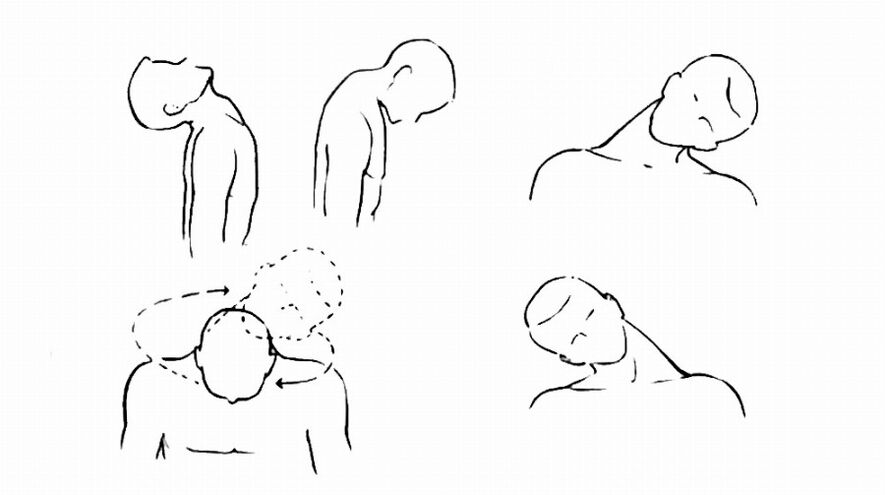Osteochondrosis of the cervical spine (CS) is most commonly diagnosed in middle-aged women and men because this section is more sensitive to stress. The first signs of the disease are often not expressed, so it is difficult to identify the problem in the early stages of development. The manifestation of osteochondrosis is associated with the impact of many factors on the body. It is important to find the root causes of cervical osteochondrosis in order for the treatment regimen to be adequate.

The main causes of the disease
Cervical osteochondrosis is a degenerative-dystrophic pathology, in which the tissues of the intervertebral discs in the neck begin to collapse under the influence of adverse factors. Over time, the disease affects other structures in the spine, resulting in impaired function. The person begins to worry about unpleasant symptoms, and his health gradually deteriorates.
The main cause of spinal degeneration is a violation of metabolic functions in the body. The vertebrae and intervertebral structures do not receive the necessary nutrients and elements. Osteophyte bone growth is seen in bone tissue. Ossification spreads over time. Initiated osteochondrosis causes immobilization of the cervical spine due to spinal fusion.
The triggering mechanism for the development of such processes are the negative factors that constantly affect the human body. The causes of osteochondrosis are:
- congenital pathologies of the structure of the musculoskeletal system,
- hereditary tendency,
- heavy physical activity,
- passive lifestyle,
- posture disorder,
- back injuries
- scoliosis,
- stress, excessive nervous load,
- complications after severe infectious diseases.
The degree and manifestation of the disease

Symptoms of osteochondrosis of the cervical spine develop gradually. As the pathology progresses, the symptoms become more pronounced. There are 4 stages in the development of chondrosis:
- Grade 1, there are no obvious signs of osteochondrosis. Sometimes headaches can cause discomfort in the neck. Symptoms pass quickly after rest, but degenerative processes have already begun in the discs where the integrity of the pulp nucleus is compromised.
- When the pathology progresses to stage 2, the intervertebral cartilage is covered with cracks through which the disc nucleus emerges. The intervertebral space is reduced, the patient complains of acute pain syndrome of the chronic form.
- In stage 3 progression, osteochondrosis of the cervical spine is characterized by severe vertebral and headache. Brain cells suffer from hypoxia, and a person may experience temporary paralysis of the limbs, hearing and vision problems. Hernias form in the cervical region, which constrict nerves, muscles, arteries and veins.
- As the disease progresses to the latter (4 tablespoons), the symptoms of cervical osteochondrosis in men and women become so obvious that the patient is unable to rest or relax for even a minute. Osteophytes form in the spine, so the mobility of the neck is impaired, and the person becomes disabled. If complex treatment is not started at this stage, the condition can end in death.
Typical symptoms
Conservatively, grade 1-2 osteochondrosis is effectively treated. In advanced cases, it is difficult to fully restore the destroyed intervertebral structures. This means that it is important to diagnose in the early stages of the disease. Therefore, if a person has similar symptoms, it is necessary to consult a doctor immediately:
- Acute pain in the neck, shoulders, localized behind the head,
- severe headaches and dizziness caused by compression of the nerves and blood vessels of the cervical spine by the vertebrae,
- visual and hearing impairment,
- muscle weakness
- numbness, feeling like goosebumps flowing down the skin
- malfunction of the vestibular apparatus.
Cervical osteochondrosis at the level of the C4-C6 vertebrae is characterized by impaired sensitivity of the upper extremities, hands and fingers. If the vertebral artery is constricted, dangerous disorders in the brain are a concern. Hypoxia occurs due to insufficient blood supply and nutrition of brain cells. If the patient is not treated in time, the patient will have memory problems, impaired swallowing function, and constriction in the throat where the apple is located.
Often, even a person's voice changes, and heart pathology occurs with the development of cervicothoracic osteochondrosis.
How is the diagnosis made?

If a person suspects that he has developed osteochondrosis of the cervical vertebra, he should see a neurologist who will perform an initial examination and try to find out the main causes of the disease. During palpation, it will be possible to determine the approximate stage of the pathology, how it progresses - with or without displacement. To confirm the diagnosis, the patient must undergo a number of instrumental diagnostic tests:
- Radiography. It will help determine the rate of growth of osteophytes, the size of the interarticular space.
- MRI or CT. Allows you to assess the degree of destruction of the intervertebral discs, as well as the condition of other soft structures.
- Doppler ultrasound. It helps to identify abnormalities in the work of blood vessels, so the blood supply to the brain is disrupted.
How can the problem be treated?
If the diagnosis is confirmed at the time of diagnosis, based on the results obtained, the doctor selects the optimal treatment regimen for cervical osteochondrosis. If the disease does not start, you can get rid of it with medication and adjuvant procedures. In stages 3-4, the medication is often weak, in which case the best solution is surgery.
An effective drug
Medical treatment of cervical spine osteochondrosis in the acute period is primarily aimed at relieving inflammation, swelling and pain. The following groups of drugs are prescribed for this purpose:
- Non-steroidal anti-inflammatory drugs. Eliminate inflammation, reduce swelling, relieve pain. With the exacerbation of the pathology, it is recommended to use it in the form of injections, when the symptoms are slightly reduced, you can take pills.
- Painkillers.
- Muscle relaxants. Eliminate muscle spasms, thereby freeing nerves and blood vessels.
- Chondroprotection. They restore damaged cartilage structures and prevent their further destruction. It is recommended to take this group of drugs for a long time for a positive effect.
- Vasodilators. They help to improve blood flow, which normalizes the nutrition of the brain.
- B vitamins. It normalizes metabolism in the body, stimulates the immune system, thanks to which soft and bone tissues recover faster.
Complex exercise therapy

With the help of therapeutic exercises, it will be possible to quickly restore the affected structures of the cervical spine. You can treat the disease by following the following methods:
- head turns in different directions,
- rotational movements,
- shoulder rotation,
- raising and lowering the head.
Physiotherapy and massage
Cervical osteochondrosis is successfully treated with the help of physiotherapeutic procedures prescribed by a doctor, taking into account the individual characteristics of the body. It is often recommended to take the following courses:
- magnetotherapy,
- laser heating,
- ultrasound,
- electrophoresis,
- applications with ozokerite,
- hydrogen sulfide and radon baths,
- ultraviolet radiation.
With the defeat of osteochondrosis of the cervical spine, it is useful to undergo a course of therapeutic hand massage. The procedure should be performed by a trained physician familiar with the diagnosis and radiographic findings. Thanks to point blows, strokes, strokes and vibrations, it will be possible to restore normal blood circulation and establish nutrition in the damaged areas.
Treatment with folk remedies

Treatment of cervical osteochondrosis is possible by non-traditional methods, but you should consult a doctor first. A compress made according to this recipe will help relieve pain, inflammation and swelling:
- Wash the cabbage leaves, cut the coarse fibers and knead well.
- Apply a mixture of honey and aloe juice (2: 1) to the leaves, distribute evenly over the surface.
- Heat the compress on steam, then apply to the neck, cover with adhesive film and a woolen scarf.
- Put on a bandage for 3-4 hours.
It is recommended to make a compress in the morning and evening - every day.
Prevention and prognosis
With timely and adequate therapy, the disease can be treated and complications can be prevented. If the problem is not treated and the doctor's advice is ignored, the prognosis is disappointing. For the prevention of cervical osteochondrosis, it is important to lead an active lifestyle, monitor posture, exercise, eat properly and consult a doctor if you have any suspicious symptoms.



















